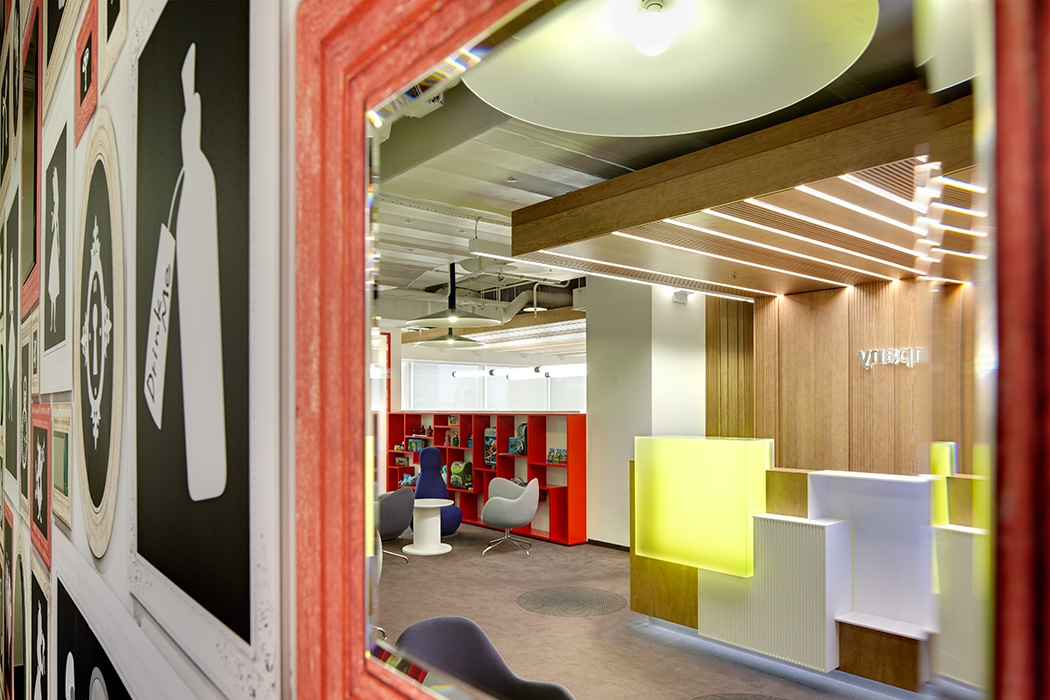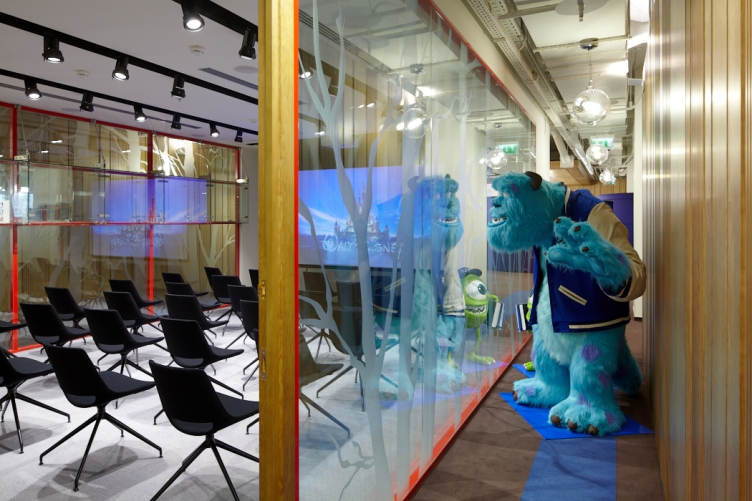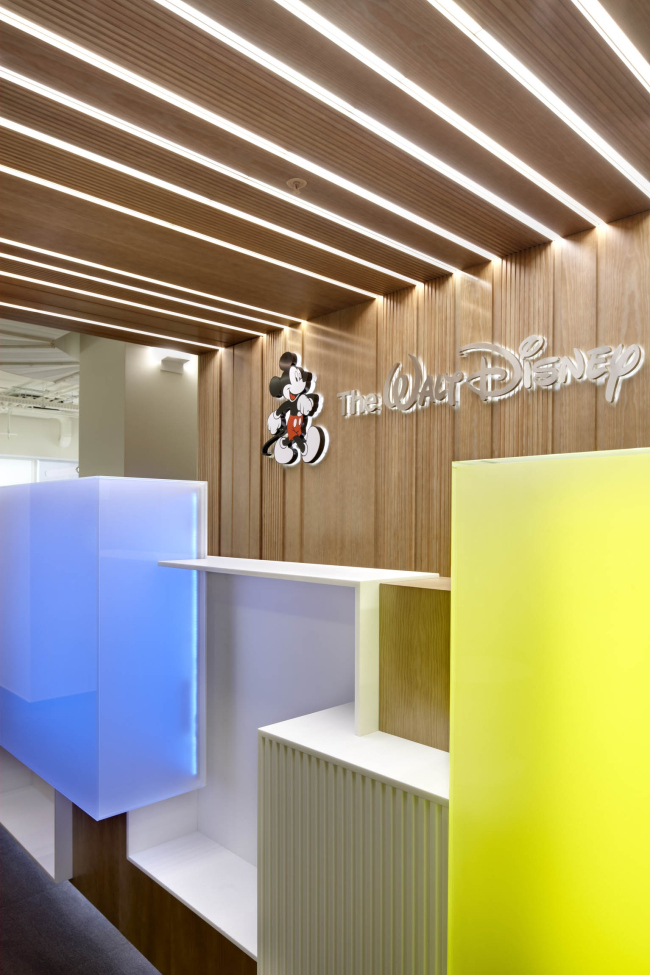
Office of Walt Disney Company © UNK project
This is not the first office of the famous corporation in Moscow, and not the first work of UNK Project for Disney either. "Walt Disney Company" have long since established its office in "Lotte-Plaza" on the Novy Arbat Street, and in 2011, UNK Project turned the office of "Walt Disney Studios Sony Pictures Releasing" located in the business center "Stanislavsky Factory" into a veritable "dream factory". An office with a fully-fledged movie hall and the inimitable charm of the Hollywood "hangar" studios became one of the architects' "calling cards" - the bureau was awarded a few prestigious awards for it. And it was only two years later that Disney turned to UNK Project for their central office - renting yet another floor, the company commissioned the bureau with a design project of their new establishment. It must be mentioned at this point that one of the key requirements was - the new office was to look nothing like the already-existing one, nor like the office of WDSSPR.

Office of Walt Disney Company © UNK project
As Nikolai Milovidov explains, it was all about the fact that the new extra office premises were to accommodate the divisions responsible for the work with the clients of Walt Disney Company. "One can safely say that this is the level of "external relationship", and the space here mainly consists of meeting rooms, showrooms, and places for less formal communication - the architect says - In other words, it is here that almost all the company's clients come, meaning, this new office is the "face" of "Walt Disney Company", and it was asking for the appropriate design". The authors of the project decided not to go too far for inspiration - it would not have been really worth the effort trying to "dream up" something magic for the company that has for decades been specializing in the creation of magic worlds. The stylistic concept was based on the story of Alice in Wonderland, one that we also know from the Disney cartoon.
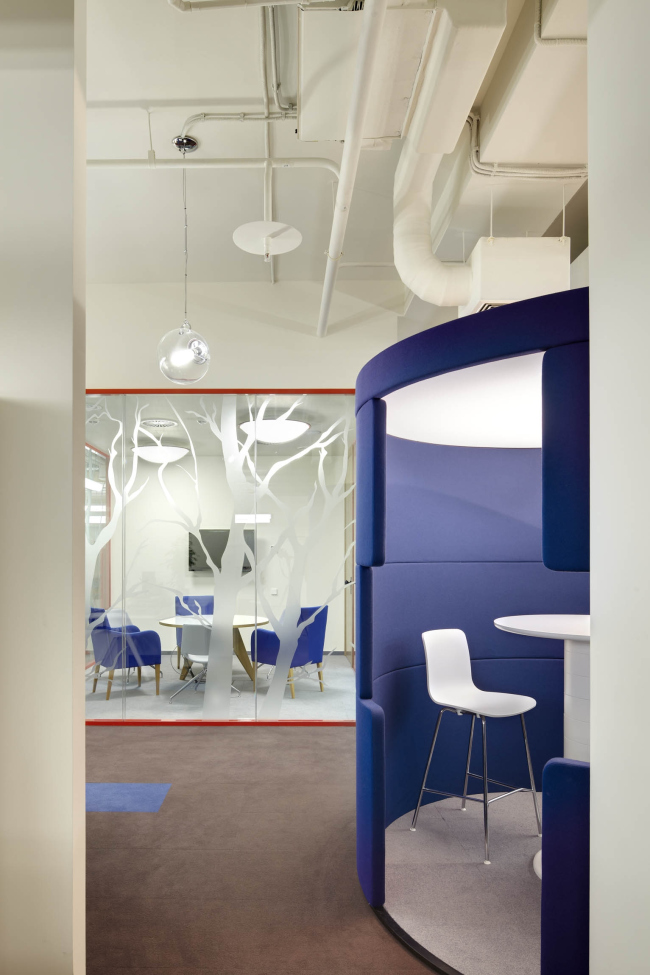
Office of Walt Disney Company © UNK project
The planning was based on the "open space" principle, although it does look that way at first glance. In strict accordance with the spirit of Carroll's tale, the architects treated this space as a chessboard, separate "fields" of which are the working areas, offices, and meeting rooms. Also, it is virtually impossible to walk from one end of the office to the other in a straight line: instead of direct passes, the architects made winding corridors and secret paths, and the visitor’s way is now and then blocked by this or that working area. "Generally, it is a mystery forest as we know it - Nikolai Milovidov comments - The blue line on the floor functions as an extra navigator. Walking upon it, the visitor gets a chance to observe from a side what is going on in each of the "fields", sometimes almost peeking, just like Alice did in the world invented by Lewis Carroll". Likening the office to a labyrinth, the architects solved a few key tasks at once: first of all, this idea helped to visually broaden the borders of this generally modest-size area, second of all, the architects were able, within the framework of the open space, to create the necessary number of intimate and isolated rooms meant both for work and also informal communication, which was one of the customer's requirements. Each turn of the "path" from one side of the office to the other was decorated as a soft zone. The single space still produces the impression of an indivisible whole - but at the same time the employees of different departments get their visual and acoustic comfort. The design of each of the fields as such also urged the architects to fantasize on the subject of Alice in Wonderland: the bright armchairs of quaint fancy shapes put one in the mind of the weird characters that the heroine meets on her way.
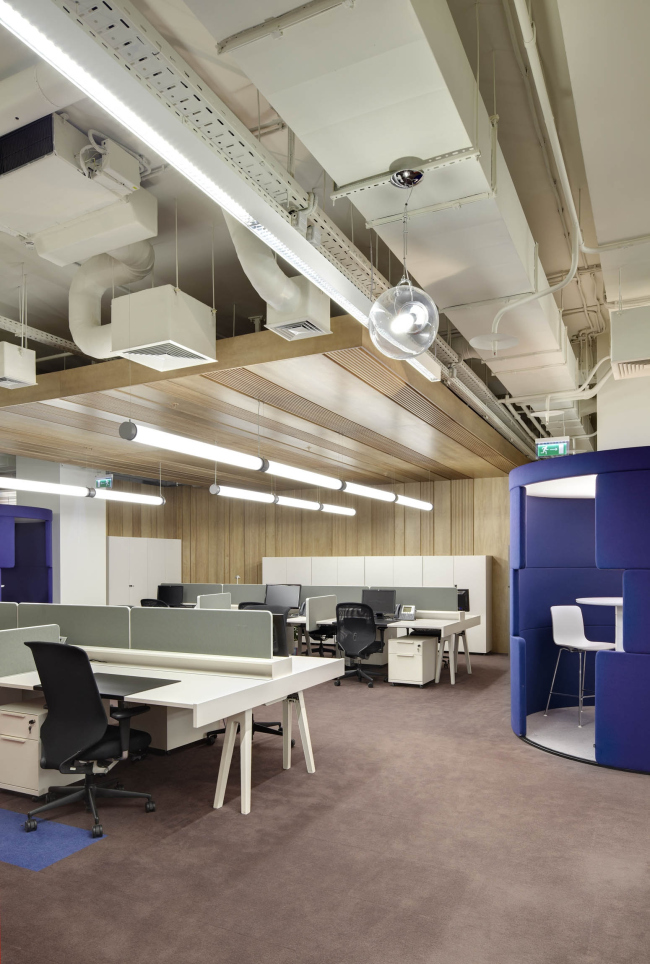
Office of Walt Disney Company © UNK project
The mystery forest and the chessboard as the two most recognizable symbols of Alice's story are used not only in the planning solution but also in the decorative design. For one, the opaque silhouettes of the trees are posted on all the glass partitions, while the left-uncovered communications form on the ceiling a sophisticated pattern that brings up the associations with the thick forest. This feeling is strengthened by the lights of all considerable shapes and sizes hanging down in between the air vents (these lights were made upon the author sketches specifically for this project). And as for the white-and-blue checkered pattern, it is used in the design of the restrooms; what is peculiar here is the fact that because of the abundance of mirrors and the polished tiles here the space gets a bit distorted producing a palpable 3D effect of being "inside the looking glass". The cafeteria is also designed in a very intriguing way - the checkered floor and ceiling with liana branches upon them are added by the walks that depict the scenes of the famous crazy tea party with March Hare.
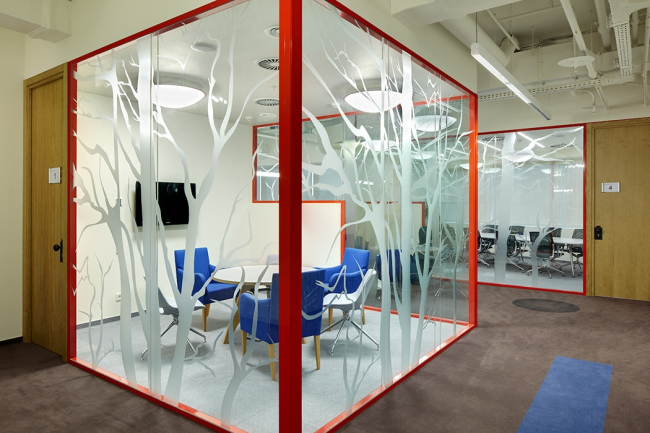
Office of Walt Disney Company © UNK project
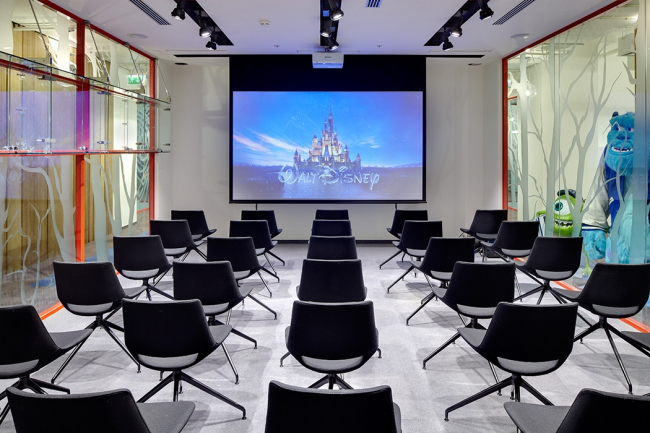
Office of Walt Disney Company © UNK project
It is generally worth mentioning that, thanks to the main theme, the design of the office turned out to be truly phantasmagoric, and this is true, first of all, for the "contents" of the decorative design. As far as its color palette is concerned, however, it turned out to be a lot more reserved - the architects simply wanted to avoid running the risk of overdoing it. The only bright color that is always there throughout the entire office is red - it runs over the partition frameworks, over the shelves, and in the picture frames in the reception zone. Again, Lewis Carroll was in it: according to the architects' idea, the red was to put one in the mind of roses, yet another important story line of "Alice in Wonderland".

Office of Walt Disney Company © UNK project
Of course, the meeting rooms and the workplaces are designed in a more reserved manner, and they are dominated by the functionality and technical equipment. As Nikolai Milovidov shares, the architects designed for Disney several unique premises that took into consideration the company specifics - for example, a meeting room for selling video content that was equipped with a plague of televisions tuned to various types of broadcasting, or a meeting room with showcases that were mean to demonstrate all kinds of souvenirs that are put out at the release of the movie. And, while the mock-ups of hedge characters of these or those cartoons may sometimes catch your eye in every corner of the office, you can only meet Alice in the reception zone. Its main adornment is the decorative wall opposite the desk that the architects turned into a panel picture with silhouettes of Lewis Carroll characters. In actuality, they are painted directly in the wall but, at the expense of the baguette frame and the base surfaces of various colors, they look as if they were cut from paper. And - between the "pictures", the architects placed a few mirrors, also of human height, which gives every visitor an opportunity to "try on" the role of a "looking-glass" hero.
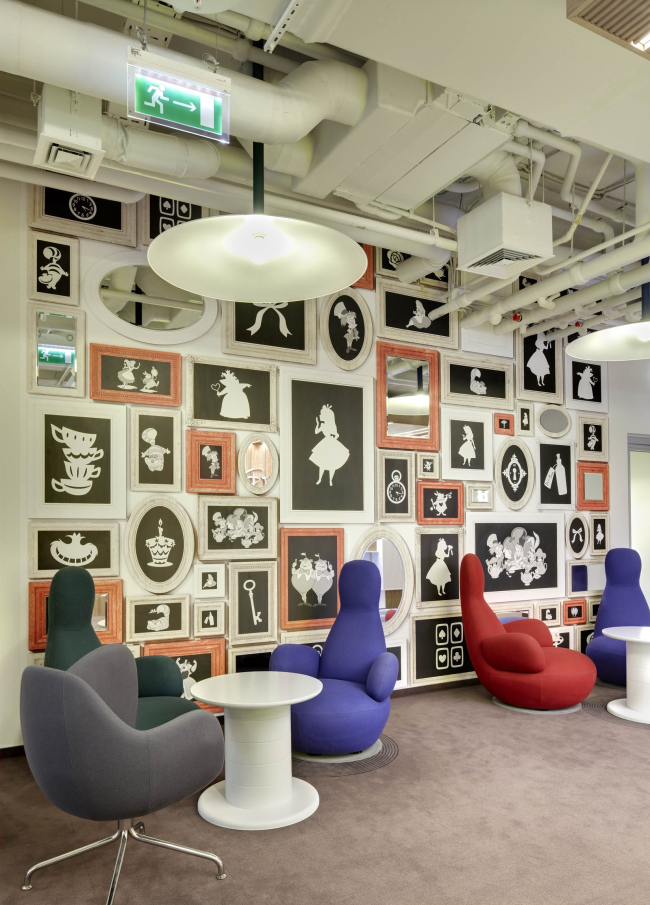
Office of Walt Disney Company © UNK project
Just as attractive is the reception desk that the architects "pieced together" from several empty cubes. Some of them look as if they were "pushed into" the wooden structure , the others, on the contrary, look as if they were "pulled out" and backlit from the inside. Simple as it looks this composition is a sure sign of "high creativity concentration" company and puts one into a positive and creative mood. Oh, by the way, the reception desk was such a success with the customers that UNK Project has already designed its replica for the "old" office as well.
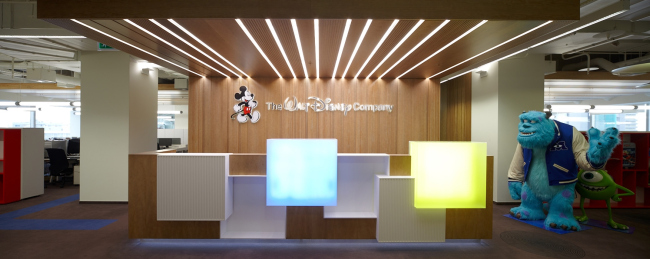
Office of Walt Disney Company © UNK project
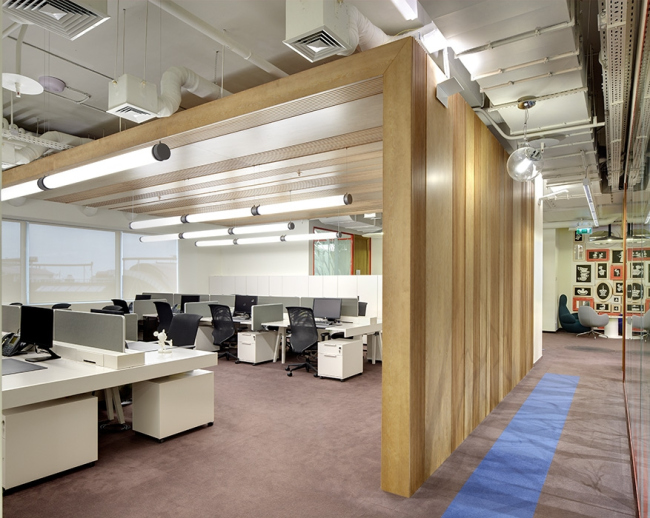
Office of Walt Disney Company © UNK project
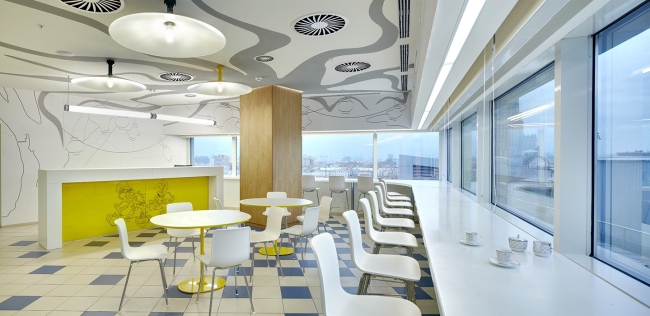
Office of Walt Disney Company © UNK project

